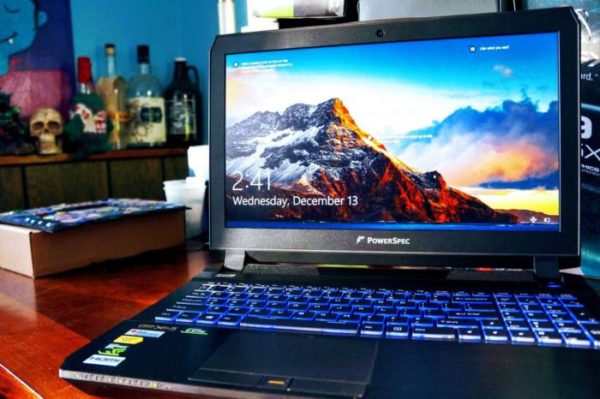Savvy electronics shoppers know Micro Center as the go-to retailer for mouthwatering CPU deals if you’re lucky enough to live near one. The company’s first-ever homegrown gaming laptops continue that devotion to damned good prices. Despite packing a full-fat GeForce GTX 1070 and other high-end hardware, the aluminum-clad PowerSpec 1510 costs a mere $1,300, and the PowerSpec 1710 just $1,400. (With in-store pickup only, of course—this is Micro Center.) That’s surprisingly little cash for such potent portable PCs!
Nvidia’s gameplay-smoothing G-Sync technology is disabled by default though, making you jump through hidden and arcane hoops to get the best experience on the PowerSpec laptops—and one of these is definitely the better buy.
PowerSpec 1510 and PowerSpec 1710 specs, features, and price
The 15.6-inch PowerSpec 1510 and 17.3-inch PowerSpec sport identical core hardware. Externals are another story. The Micro Center laptops use two very different Clevo cases, and that leads to two wildly different user experiences.
- CPU: Core i7-7700HQ
- GPU: Nvidia GeForce GTX 1070
- RAM: 16GB DDR4/2400
- Storage: 1TB HGST 7200RPM hard drive, 250GB Samsung 960 EVO NVMe M.2 SSD
- Wireless: 802.11ac, Bluetooth 4.1
- Display (1710): 17.3-inch, 60Hz 1920×1080 IPS, or 75Hz with G-Sync active (disabled by default)
- Display (1510): 15.6-inch, 60Hz 1920×1080 IPS, G-Sync (disabled by default)
- Weight (1710): 6 lb. 14.6 oz., or 8 lb. 14.2 oz. with power brick
- Weight (1510): 6 lb. 9.4 oz., or 8 lb. 14.4 oz. with power brick
- Dimensions (1710): 16.5 x 11.5 x 1 inches
- Dimensions (1510): 15.25 x 10.75 x 1.25 inches
- Webcam: 1080p
- Price: $1,300 for PowerSpec 1510, $1,400 for PowerSpec 1710
We’ll discuss the port selection as part of the overall design talk in a later section.
You won’t find any lightweight Nvidia Max-Q subtlety here. The GeForce GTX 1070 lurking inside is the full-fat version, and the PowerSpec laptops are old-school bruisers at an inch (or more!) thick and nearly 7 pounds. of heft beforeyou add in the power brick. That raw bulk lets Micro Center cram top-of-the-line hardware into the PowerSpec 1510 and PowerSpec 1710. With a Core i7-7700HQ, 16GB of RAM, and a helpfully fast Samsung 960 EVO NVMe boot drive, these beasts were built to spit out blistering frame rates.
The curious case of (kinda) missing G-Sync
But bizarrely, G-Sync—the Nvidia technology that synchronizes the refresh rate of the GPU and display to eliminate tearing and stuttering—isn’t active by default. The Nvidia Control Panel won’t let you turn it on, either. What?
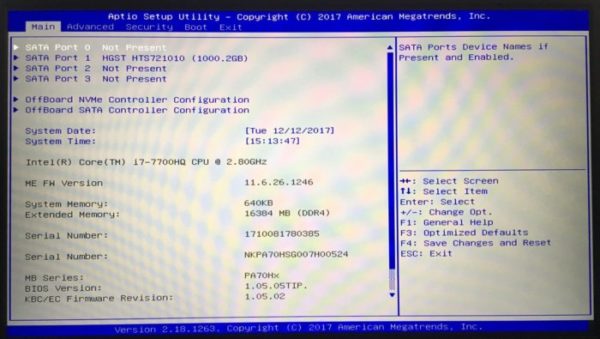
Brad Chacos/IDG
As it turns out, the PowerSpec laptops ship with Microsoft Hybrid Graphics mode enabled by default. Hybrid mode switches off the discrete GPU and shifts the workload over to the Intel CPU’s integrated graphics when face-melting visual power isn’t required. It saves battery life, but G-Sync won’t—can’t—function using Hybrid mode. G-Sync demands secret sauce from Nvidia GPUs 100 percent of the time. To activate G-Sync, you need to boot into the system BIOS and head to the Advanced tab. There, select Advanced Chipset Control and change the “MSHybrid or DISCRETE Switch” option to Discrete. Reboot the PC, give the system a second to think, and you’ll receive a prompt to enable G-Sync in the Nvidia Control Panel.
Fortunately you’ll only need to this once—but it’s ludicrous that you need to do it at all. The PowerSpec laptops ship with a flagship feature disabled. Worse, the activation’s hidden behind an arcane process that’s never made obvious to end users. And get this: Switching to the discrete GPU bumps the PowerSpec 1710’s display refresh rate from the default 60Hz up to 75Hz. (No such luck on the PowerSpec 1510, alas.) I’ve never seen a laptop configured this way and honestly, the only reason I puzzled out the solution was because I saw an Intel graphics option while right-clicking the desktop and was savvy enough to recognize what that indicated. It’s not consumer-friendly whatsoever.
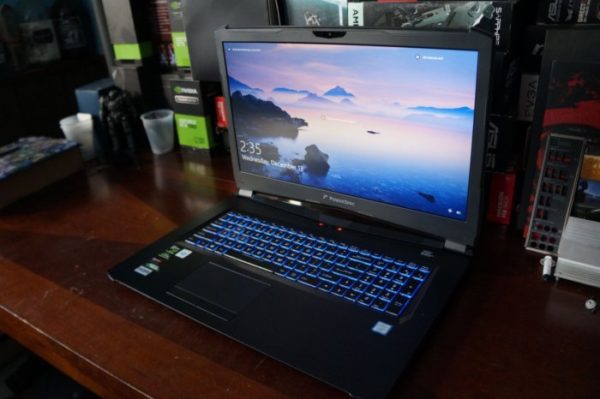
Brad Chacos/IDG
Once you’ve gotten that all squared away, the results are spectacular. Both Micro Center notebooks boast vivid displays with wide viewing angles. The PowerSpec 1510 is no slouch with its better-than-average 317 nits of brightness, but the PowerSpec 1710 maxes out at an eye-searing 411 nits—easily one of the brightest displays we’ve seen, alongside the Alienware R15and monstrous Acer Predator 21 X. With G-Sync active, gaming on these displays with the GTX 1070’s raw power is nothing short of glorious.
The big difference: Physical design
The PowerSpec laptops rely on Clevo cases. These are classic big, heavy gaming laptops—though far from the heaviest we’ve seen. Both designs sport a slick-looking (and fingerprint-prone) black casing, but differ greatly in other aspects.
The PowerSpec 1510 is the thicker of the two at 1.25 inches, but slightly more compact than its sibling at 15.25 x 10.75 inches. Ports abound on this beast, and on almost every edge. You’ll find a Mini-DisplayPort, a pair of USB 3.1 Type-C ports, and a pair of standard USB 3.1 Type-A connections on the leftmost edge. On the right edge, there’s another USB 3.1 Type-A connection, an ethernet jack, an SD card slot, a Kensington lock slot, and microphone, headphone, and line out jacks. Finally, you’ll find power input, a full-sized HDMI connection, and another Mini-DisplayPort awkwardly placed on the rear. (Whew!)
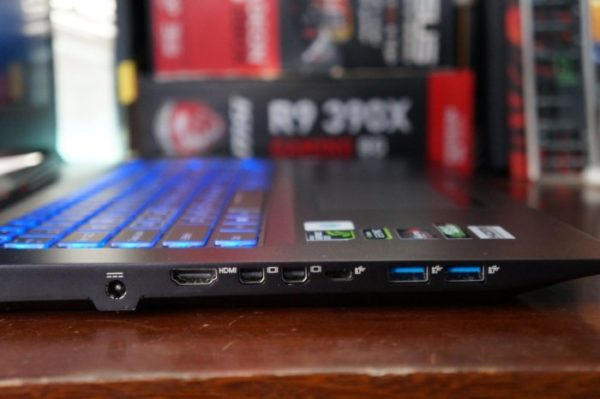
Brad Chacos/IDG
Ports are handled differently on the larger PowerSpec 1710. You (thankfully) don’t find any connections on the rear. On the left edge, there’s power, HDMI, a pair of Mini-DisplayPorts, a pair of USB 3.1 ports, and a single USB 3.1 Type-C connection complete with Thunderbolt 3 support. The right edge packs another pair of USB 3.1 ports, SD card and Kensington lock slots, ethernet, and mic/headphone/line out jacks.
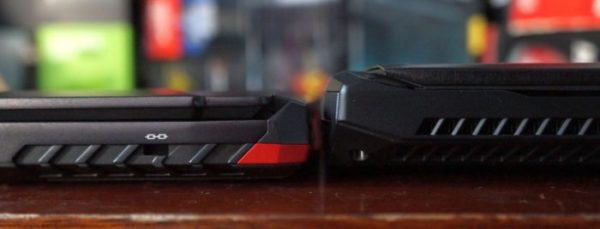
Brad Chacos/IDG
The 17.3-inch laptop naturally measures in a bit wider and longer than its smaller cousin, at 16.5 x 11.5 inches. Despite that it appears sleeker to my eye due to being one inch thick—a quarter-inch thinner than the PowerSpec 1510. The decision to reduce the height may not have been a smart one, though. The PowerSpec 1710 suffers from reduced performance during extended usage, while the PowerSpec 1510 doesn’t. We’ll cover that in detail during the performance section.
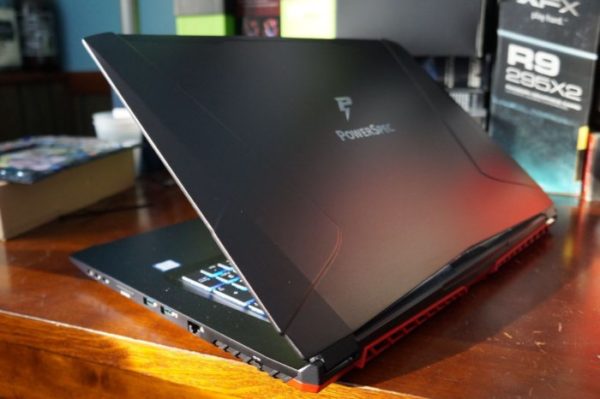
Brad Chacos/IDG
The angular rear exhausts on the PowerSpec 1710 are painted an obnoxious “gamer red” color that coordinates with a pair of red RGB lights on either side of the triangular power button found front and center underneath the display. The PowerSpec 1510 sticks to black aluminum throughout, augmented by blue lighting under its keyboard and a more subdued rectangular power button. That better fits my personal tastes, though both laptops include software that let you customize the keyboard’s RGB backlighting by region.
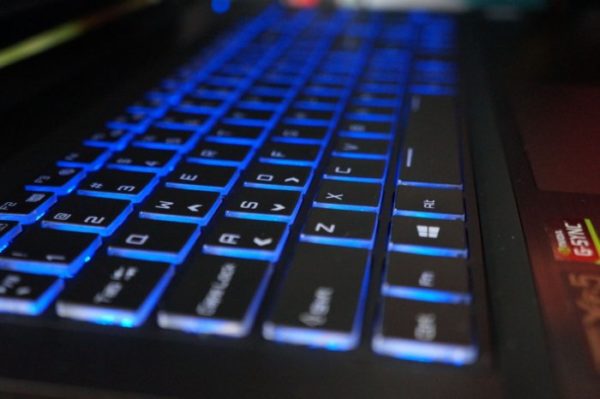
Brad Chacos/IDG
Both PowerSpec laptops sport standard-issue Clevo keyboards. They’re as eh, okay as ever. I prefer the deeper key travel of the PowerSpec 1510; the shallower keys of the PowerSpec 1710 bottom out more frequently and feel less comfortable. The touchpads prove smooth and accurate, though the buttons are a bit too mushy—another common Clevo complaint. The PowerSpec 1510 embeds a fingerprint reader between those buttons, while the PowerSpec 1710 lacks any biometric support.
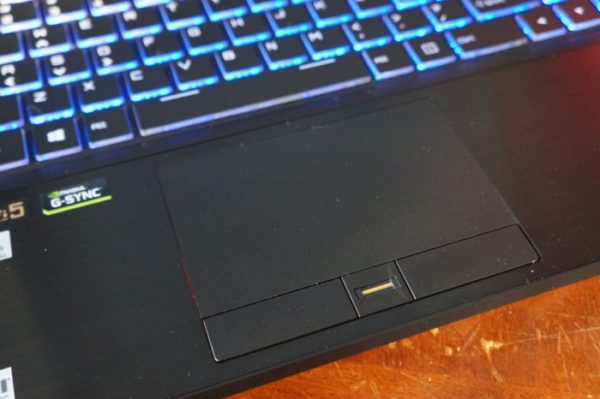
Brad Chacos/IDG
Audio differs between the two laptops as well. SoundBlaster handles the PowerSpec 1710’s audio, and the results are decent. The laptop gets nice and loud, but kind of blare-y at high volume. The audio can also sound curiously flat sometimes, though it’s clear overall and has a decent bass punch. The PowerSpec 1510 also packs SoundBlaster tech, but it’s bolstered by an ESS Sabre HiFi DAC and Texas Instruments Burr-Brown Audio. It sounds surprisingly good, with crisp, clear tones. Deep bass adds a warm feel. But the maximum volume is also surprisingly quiet—you won’t be cranking this notebook to 11. As ever, we recommend buying a nice gaming headset to pair with your gaming laptop.



